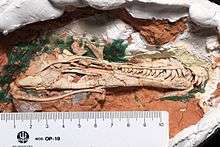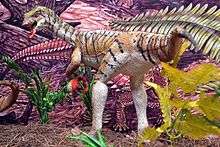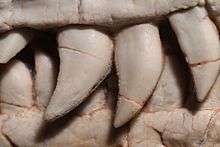Buriolestes
| Buriolestes Temporal range: Carnian, 237–228 Ma | |
|---|---|
.jpg) | |
| Block containing the holotype fossil | |
| Scientific classification | |
| Kingdom: | Animalia |
| Phylum: | Chordata |
| Class: | Reptilia |
| Clade: | Dinosauria |
| Order: | Saurischia |
| Clade: | Eusaurischia |
| Suborder: | †Sauropodomorpha |
| Genus: | †Buriolestes Cabreira et al., 2016 |
| Species: | †B. schultzi |
| Binomial name | |
| Buriolestes schultzi Cabreira et al., 2016 | |
Buriolestes (meaning "Buriol's robber") is a genus of early sauropodomorph dinosaurs from the Late Triassic of Brazil. It contains one species, B. schultzi, named in 2016. The type specimen was found alongside a specimen of the lagerpetid dinosauromorph Ixalerpeton.[1]
Description

Although Buriolestes superficially resembles the predatory theropod dinosaurs, with jaws lined by finely serrated and slightly curved teeth well-adapted to a carnivorous diet, it in fact is an early member of the otherwise-herbivorous Sauropodomorpha, the group that gave rise to the giant sauropods. Characteristically sauropodomorph traits seen in Buriolestes include a downturned jaw tip and a long deltopectoral crest on the humerus. However, Buriolestes also lacks a small head and enlarged nostrils, which are typical among sauropodomorphs, and the medial condyle on the end of its tibia projects backwards, a distinctive feature (autapomorphy) unique to this animal.[1]
In Buriolestes, the shaft of the pubis is straight, in contrast to later sauropodomorphs, where it has been modified into an expanded "apron"; theropods, where it forms a "boot"; and all ornithischians, where it is reversed and is parallel to the ischium. Additional traits differentiate Buriolestes from both later and contemporary sauropodmorphs: the front expansion (preacetabular ala) of the ilium is relatively tall, the outer edges of the pubis are bevelled, the trochanter of the femur forms a shelf, and the metatarsal of the fifth digit on the foot is relatively long.[1]
Discovery and naming
The holotype specimen, ULBRA-PVT280, was discovered in the Buriol ravine in São João do Polêsine, Brazil. These rocks are part of the Santa Maria Formation, which dates to the Carnian epoch. The specimen consists of a single skeleton preserving parts of the skull, vertebrae, left forelimb, and left hindlimb. Another set of smaller bones is also present, which may belong to a juvenile or a different taxon altogether. Two individuals of Ixalerpeton were also preserved closeby.[1]
In 2016, the specimen was named Buriolestes after the Buriol family; the suffix -lestes is Greek for "robber". The specific name honours palaeontologist Cezar Schultz.[1]
Classification

A phylogenetic analysis conducted in 2016 affirmed the sauropodomorph affinities of Buriolestes. Part of the phylogenetic tree from the study is shown below.[1]
| Dinosauria |
| |||||||||||||||||||||||||||||||||||||||||||||||||||||||||||||||||||||||||||||||||||||||||||||
| |
Paleoecology

The shape of the teeth of Buriolestes suggest that it was a carnivore which fed on small vertebrates and invertebrates, which provides evidence that sauropodomorphs - and likely all saurischians and dinosaurs as a whole - were ancestrally carnivorous, and that sauropodomorphs, ornithischians, and various groups of theropods independently became herbivorous.[1]
The co-occurrence of Buriolestes and Ixalerpeton parallels the simultaneous presence of dinosaurs and non-dinosaur dinosauromorphs at other sites (such as the Ischigualasto[2] and Chinle[3] Formations), suggesting that, after their initial evolutionary radiation, dinosaurs did not rapidly replace their dinosauromorph precursors.[1]
References
- 1 2 3 4 5 6 7 8 Cabreira, S.F.; Kellner, A.W.A.; Dias-da-Silva, S.; da Silva, L.R.; Bronzati, M.; de Almeida Marsola, J.C.; Müller, R.T.; de Souza Bittencourt, J.; Batista, B.J.; Raugust, T.; Carrilho, R.; Brodt, A.; Langer, M.C. (2016). "A Unique Late Triassic Dinosauromorph Assemblage Reveals Dinosaur Ancestral Anatomy and Diet". Current Biology. doi:10.1016/j.cub.2016.09.040.
- ↑ Martínez, R.N.; Apaldetti, C.; Alcober, O.A.; Colombi, C.E.; Sereno, P.C.; Fernandez, E.; Malnis, P.S.; Correa, G.A.; Abelin, D. (2013). "Vertebrate succession in the Ischigualasto Formation". Journal of Vertebrate Paleontology. 32 (Supplement 1: Memoir 12: Basal sauropodomorphs and the vertebrate fossil record of the Ischigualasto Formation (Late Triassic: Carnian-Norian) of Argentina): 10–30. doi:10.1080/02724634.2013.818546.
- ↑ Irmis, R.B.; Nesbitt, S.J.; Padian, K.; Smith, N.D.; Turner, A.H.; Woody, D.; Downs, A. (2007). "A Late Triassic Dinosauromorph Assemblage from New Mexico and the Rise of Dinosaurs". Science. 37 (5836): 358–361. doi:10.1126/science.1143325.